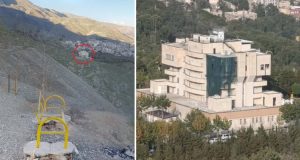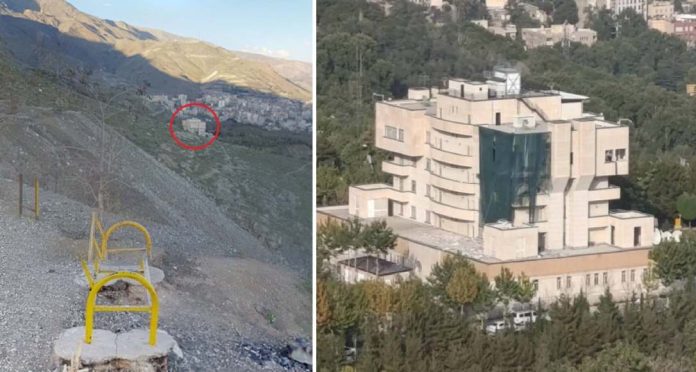By Kayhan Life Staff
Islamic Republic officials claim that Ismail Haniyeh, the political leader of Hamas, was killed on July 31 after a “guided missile” controlled from outside Iran hit the heavily guarded complex where he lived in Tehran.
However, the New York Times, citing “sources,” has reported that the Israeli intelligence agency Mossad assassinated Haniyeh by detonating a bomb that was previously planted in that building.
“Ismail Haniyeh, a top leader of Hamas, was assassinated on Wednesday by an explosive device covertly smuggled into the Tehran guesthouse where he was staying, according to seven Middle Eastern officials, including two Iranians, and an American official,” the New York Times said.
“The bomb had been hidden approximately two months ago in the guesthouse, according to five of the Middle Eastern officials. The guesthouse is run and protected by the Islamic Revolutionary Guards Corps (IRGC) and is part of a large compound, known as Neshat, in an upscale neighborhood in northern Tehran,” the paper added.
The guest house where Haniyeh stayed is in an area safeguarded by the IRGC. The complex, which forms part of a specialized rehabilitation center for veterans, is at the base of the Velenjak Heights in northern Tehran. This location is significant, as it provides a strategic vantage point for monitoring the surrounding area, and makes it a highly secure site.
On the northern edge of this complex are hilltop views of Tehran, while the southern side features residential homes. Based on available evidence, IRGC officers patrol the streets day and night, in shifts.

The circumstances of the assassination of Haniyeh are shrouded in uncertainty. Conflicting reports and speculation regarding the methods employed in the operation add a layer of complexity to the situation, leaving many questions unanswered.
Some sources suggest that the explosion was triggered using an explosive quadcopter, also known as a quadrocopter or quadrotor. This type of drone can be equipped with explosives and operated remotely, allowing for precision strikes from a distance.
Others suggest that Haniyeh’s residence was struck using a Laser-Guided Mini Missile System.
During a press conference on July 31 in Tehran, Khalil al-Hiyya, the Hamas representative in Gaza, said that according to eyewitness accounts, Haniyeh was killed when “a missile entered the room.”
Al-Hiyya said Haniyeh received a “direct hit” within the confines of his room. This claim bolsters the hypothesis that a rocket was launched from locations near the building, since Velenjak Heights provides an unobstructed view of Haniyeh’s residence.
The assassination of Haniyeh has not only raised questions about the security measures within the Islamic Republic but has also led to significant tensions and suspicion. Several factions have accused the Islamic Republic and the IRGC, stating that Haniyeh’s killing was orchestrated by individuals associated with the Islamic Republic who collaborated with Israel.
In reaction to the assassination of Haniyeh, Abdul Hamid Khorasani (also known as Nasser Badri), who leads the Taliban’s Badri Brigade, stated in a video shared on social media that the Islamic Republic was involved in Haniyeh’s death. He further claimed that the Islamic Republic maintained a “shadow” and covert alliance with both America and Israel.
Some social media users contend that the Islamic Republic favors The New York Times’ coverage regarding the assassination method of Haniyeh, as it shifts accountability away from Iranian intelligence agencies and the IRGC security detail responsible for Haniyeh’s protection.
It is widely recognized that the Iranian government has been infiltrated by individuals conducting undercover missions such as the assassination of Haniyeh. These operatives are positioned so closely within the inner circles of security that they had precise knowledge of Haniyeh’s movements.

Specifically, they knew the exact time and location of his presence during the inauguration ceremony for Iranian President Massoud Pezeshkian, which was not publicized beforehand. Other details about Haniyeh’s presence in Tehran, such as the length and location of his stay, were also closely guarded.
The intelligence agencies of the Islamic Republic of Iran appear to have launched a campaign to put out various narratives regarding the assassination method of Haniyeh. This is to distract from their security shortcomings and failures and their involvement in this operation.
Certain government officials, including specialists from the Islamic Republic of Iran Broadcasting (IRIB), have gone as far as attributing the oversight to Haniyeh and his security personnel. Some have blamed Haniyeh and his bodyguards, arguing that they may have been compromised because of their mobile phone signals or WhatsApp accounts.
There is considerable speculation regarding the execution of this operation, and internal and external sources are consistently presenting various conflicting issues. These sources often cite experts, officials, or “sources,” as well as unnamed informants.
There has been a significant surge in accusations against the intelligence and security agencies of the Islamic Republic recently, which have been labeled as seriously incompetent and failing on a grand scale. In response to the assassination of Haniyeh, the conservative Tehran newspaper Jomhouri-e Eslami wrote: “The primary issue lies in the existence of infiltrators among us.”
“Israel’s ability to launch a rocket that can precisely strike Ismail Haniyeh’s bedroom window in a highly secure area of Tehran and turn him into a martyr signifies nothing other than the presence of infiltrators within our ranks by this criminal regime,” Jomhouri-e Eslami said.
The paper argued that “to ensure protection against terrorist attacks, it is essential first to enhance our capabilities for intercepting enemy missiles and implement a comprehensive reform of our intelligence and security gathering processes.”
“More crucial than seeking vengeance is obstructing adversaries’ infiltration routes. It is equally vital to detect and penalize agents who resemble the Iranian counterparts of ‘Eli Chen,’ as they infiltrate the highest levels of government through deceit and are primarily responsible for orchestrating assassinations,” the paper added.
Eli Cohen, an Israeli intelligence operative active during the late 1950s and early 1960s, is renowned for his espionage activities in Syria. Through his ability to integrate into Syrian society, he gained significant influence within the Syrian government, ultimately attaining the role of deputy minister of defense. This position allowed him to gather critical intelligence for Israel despite being known as one of the most fervent anti-Israeli figures among Syrian officials.
Cohen’s operations were reportedly instrumental in providing Israel with valuable insights into Syrian military strategies and capabilities. However, his cover was eventually compromised, leading to his capture by Syrian authorities and execution in 1965.
The Turkish media claims that the authorities of the Islamic Republic alerted Hassan Nasrallah, the secretary general of Lebanese Hezbollah, about security threats concerning potential assassination attempts against leaders of the “Axis of Resistance.”
The warning reportedly discouraged Nasrallah from traveling to Tehran for President Pezeshkian’s inauguration ceremony. However, a similar warning was reportedly not extended to Haniyeh.
Hamas Names Oct 7 Mastermind Sinwar as Leader After Haniyeh Assassination


